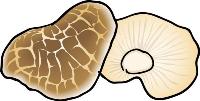Interactions
HOW DOES GANODERMA APPLANATUM INTERACT WITH A HOST?
*SAPROBIC INTERACTIONS
Ganoderma applanatum can be free-living/saproboic or parasitic; it is mostly sabroboic on old, already dead stumps and trees. Artist's Conk is most common to find this fungus being sabroboic rather than parasitic, but both can occur.
*PARASITIC INTERACTIONS
The parasitic form of Ganoderma applanatum is a major wood-rotting group. It is parasitic in certain hardwood trees; when in this parasitic form, the fungus causes a white rot, which attacks both lignin and cellulose within the tree. The rot is white because some cellulose is left behind in the path of destruction. The rot attacks the top of hardwood trees, the heartwood inside, and the base of the stem. Once the tree is infected, the fungus cannot be killed; the fungus will absorb nutrients and flourish while the tree will die. This parasitic form causes millions of dollars in damage through lost wood production and lumber decay; this is considered a downfall for some industries, but there are upsides to this as well. The infected trees provide shelter for other organisms, such as birds and squirrels. This white rot fungi also converts wood chips to paper pulp, called biopulping. This is a new way to reduce energy and pollutants while making paper. Lastly, this white rot fungus can also destroy toxic chemicals like PCBs, man-made chemicals, that are put into the soil.
DOES GANODERMA APPLANATUM ACT AS A HOST FOR OTHER ORGANISMS?
In my research, I found one organism that feeds on Ganoderma applanatum, which is called the forked fungus beetle. Humans could eat this mushroom, but it doesn’t taste as good as other edible mushrooms. This fungus is corky and I honestly would not even bother eating these. Even though I have only come across one organism, I am sure there are more organisms, such as insects, that feed from this bracket.
HOW WAS THIS FUNGUS USED YEARS AGO AND/OR PROBABLY STILL NOW?
Humans use this fungus in MANY different ways. When burned, the smoke of the burning bracket acts as an insect repellent. Along with a repellent, this fungus used to be made into herbal teas and remedies by grounding the fruiting body into a powder. Artist’s Conk is used to make etchings and beads. Look at all these uses; humans are lucky to have this fungus! Just wait; it gets BETTER!
DOES GANODERMA APPLANATUM HAVE ANY MEDICINAL PROPERTIES?
Nowadays, the Chinese and Japanese continue to use Ganoderma applanatum
(and other Ganoderma species) as a way to prevent and treat a number of
diseases, including hepatitis, hypertension, chronic bronchitis, bronchial
asthma, hyperglycemia, rheumatism, and cancer. In China, Ganoderma
applanatum and other Ganoderma species have helped to reduce saracoma 180
(cancer in connective tissues) in white mice, to treat esophageal carcinoma
(malignant tumor with epithelial cells), and to treat rheumatic tuberculosis. Chinese medicine
has also found Ganoderma species to be helpful in other ways, such as
relieving pain, removing heat, resolving indigestion and hemostasis, and
reducing phlegm. Steroids, fatty acids, applanoxidic acid, ganoderic acid,
ganoderenic acid, and furanoganoderic acid were also taken from extracts of
the fruiting bodies. In the medical field of the United States, many
bioactive compounds found in higher basidiomycetes, including Ganoderma
applanatum, show antitumor, antimicrobial, antibronchial asthma,
immune-stimulating, immune-regulating, liver- protecting, anti-hypertensive,
anti-hyperglycemic, anti-allergic and anti-oxidative properties. I bet that
blew you out of the water. Who knew that fungi were so helpful to our
health? Antibacterial properties were also found in the tube layers of
Ganoderma applanatum. The antibacterial properties only fight against
gram-negative bacteria, NOT gram-positive bacteria. Ganoderma applanatum has
been found to fight cancer. It prevents tumor growth and increases white
blood cell activity. G. applanatum doesn’t only help fight cancer, but also
helps fight diabetes and the complications that come with that disease.
Extracts from Ganoderma applanatum lower glucose, cholesterol, and
triglyceride levels significantly. This fungus is used to treat or helpthese
different diseases; remember, there is a lot more detail associated with the
specific tests and experiments. I chose to keep it short; therefore, if you
want to learn more about Artist's Conk medicinal properties, check out the
references!
NEXT PAGE = INTERESTING FACTS
 Artist's Conk (Ganoderma applanatum)
Artist's Conk (Ganoderma applanatum)